War Starts At Midnight: The Three Wartime Visions of Michael Powell and Emeric Pressburger by Josh Spiegel
By Yasmina Tawil
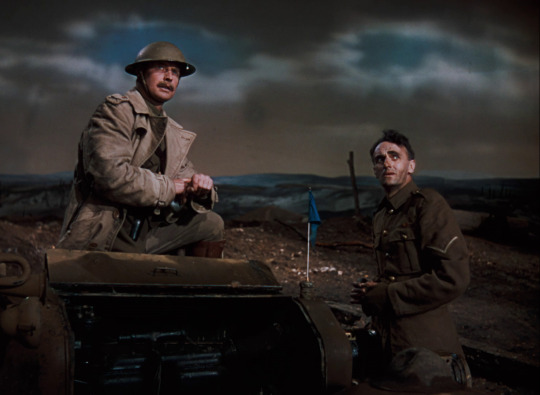
Few filmmakers have made films as thematically rich as those from writers/directors Michael Powell and Emeric Pressburger in the 1940s. From 1943 to 1949, Powell and Pressburger, better known as the Archers, made seven superlative films that leapfrog genres with heedless abandon, from wartime epic to fantastical romance to psychosexual thriller to ballet drama. Thanks largely to cinephilic champions such as Martin Scorsese and his longtime editor Thelma Schoonmaker (who married Powell in 1984), as well as home-media ventures like The Criterion Collection, the Archers’ films have received a vital and necessary second life.
While the Archers’ 1940s-era septet have recognizable throughlines as well as a reliable stable of performers, three of those films are cut from the same cloth, despite telling radically different stories with varying tones. The Life and Death of Colonel Blimp, A Canterbury Tale, and A Matter of Life and Death all take place, at least in part, during World War II, and all three films depict a nation at war, as much with other countries as with itself. When we think of British culture, we think of the stiff-upper-lip mentality depicted in popular culture for decades, typified by how Brits acted and reacted in World War II. But the Archers, in this wartime trio, debated the validity of fighting a war with that old-fashioned mentality, offering up films designed to be propagandistic enough to be approved for release but that also asked what it meant to be British in seemingly perpetual wartime.
* * *
“But war starts at midnight!” – Clive Wynne-Candy
“Oh, yes, you say war starts at midnight. How do you know the enemy says so too?” – Spud Wilson
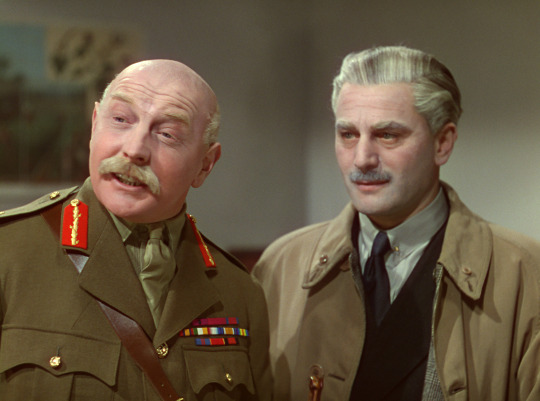
The nuance of The Life and Death of Colonel Blimp was likely always going to make it a sore spot for the British government. Colonel Blimp was not original to The Archers; he was a comic-strip character created by David Low in the 1930s, meant to skewer puffed-up elder statesmen of the British military. The stereotype of a fatheaded, pompous fool had pervaded the national consciousness so much that Winston Churchill feared the Archers’ adaptation would revive the public’s critical perception of the military when support was needed the most. But while the title invokes Colonel Blimp, the lead character is never referred to as Blimp, and is much less foolish than he may seem when initially seen attacking a young British soldier in a Turkish bath. Powell and Pressburger used the character and the staid, fusty old notions of British militarism as a jumping-off point for a detailed, poignant character study.
Set over four decades, The Life and Death of Colonel Blimp begins near its finale, as Great Britain struggles to gain a foothold over the Nazis. We first see our Colonel Blimp, the portly, bald, and mustachioed Clive Wynne-Candy (Roger Livesey), beset upon by younger soldiers in the club where he now lives as part of a training exercise. Clive is infuriated because they’ve started hours earlier than planned; before the smug young soldier leading the charge can explain himself, the two get into a tussle that speaks to why Powell and Pressburger wanted to tell this story. In the production of their previous film, One of Our Aircraft is Missing, the directors removed a scene where an elderly character tells a younger one, “You don’t know what it’s like to be old.” (The idea that this could serve as the thematic backbone to an entire feature was provided by the Archers’ then-editor, David Lean.) Clive’s rage at being taken off-guard leads him to thrash young Spud Wilson and teach him a lesson: “You laugh at my big belly, but you don’t know how I got it! You laugh at my mustache, but you don’t know why I grew it!”
And so, The Life and Death of Colonel Blimp flashes back 40 years, a rare instance where a movie indulging in the now-hoary in medias res technique pays dramatic dividends. The rest of the film focuses on three points in the life of the man known first as Clive Candy: his time in the Boer War, the devastating World War I, and his twilight years of service as World War II ramps up. For a war film, The Life and Death of Colonel Blimp offers exceedingly little bloodshed. Powell and Pressburger’s film examines how such gruesome action informs men like Clive away from the battlefield, instead of depicting that action in full. Each section of Blimp shows how his noble efforts make him hardened and intractable over time, even against the tide of a truly tyrannical force. At first, Clive’s militaristic mantra is honorable: “Right is might.” But as the film reaches its third hour, he learns that his theory, one embodied by his nation, has been so cruelly disproven by the Nazi scourge that he and Britain must change their ways.

In the earliest section, Clive steps to the aid of Edith Hunter (a young Deborah Kerr), a British governess in Berlin who’s concerned about a German soldier spreading anti-British lies regarding their treatment of South African women and children in the Boer War. In so doing, and after insulting high-ranking German officers, Clive must duel with a German soldier chosen by lot, Theo Kretschmar-Schuldorff (Anton Walbrook). Watching a Brit face off with a German soldier might’ve felt appropriate, at least to the watchful eye of the British government. But Powell and Pressburger shrewdly show us the build-up to the duel itself, not the actual fight; instead, we see the aftermath, as Clive and Theo both convalesce in the same hospital, become close friends, and fall in love with Edith. Only Theo is lucky enough to win her heart; though Edith has as much love in her heart for Clive as for Theo, Clive only grasps his feelings once she’s left his life.
Portraying Theo, the film’s major German character, as surprisingly decent is one significant way in which the Archers brought nuance to what might have been another propagandistic WWII-era film. His innate humanity becomes heartbreaking as the film progresses. In the second section, Theo is a prisoner of war who’s initially too proud to admit his previous connection to Clive, before they reunite briefly. In the final section, Theo is older and much wiser than his friend, yet no luckier. He’s seen in a British immigration office, attempting to leave Germany on his own: his two sons have become Nazis and Edith has passed away. (“None of my sons came to her funeral. Heil Hitler,” Theo says grimly.) Theo then explains what drew him back to the UK, in a measured yet passionate soliloquy. No matter how many faults Theo sees in the Brits—after he reconnects with Clive post-WWI, Theo tries to point out that regular citizens “can’t be adjusted from war to peace as easily as you”—it is still a far kinder place to live than Germany. That the film’s most impassioned speech, expressing fondness for the British way of life, comes from a German is one of its many welcome surprises.
The film’s most haunting twist revolves around the women in Clive’s life. When Edith joins Theo in Germany, Clive is so shaped by her memory that when he settles down and marries the charming Barbara Wynne, she just so happens to look like Edith’s twin. Barbara, like Edith, passes away before World War II begins, but though Clive has aged, he hasn’t changed; his driver, Angela “Johnny” Cannon, looks just like Barbara and Edith, to the point where he introduces Johnny to Theo, fully aware that both men spot the similarity. Kerr, thus, is playing three strong-willed women, all of whom feel like perfect fits with the men of the film.
Clive, like his country, stays firmly and proudly rooted in the past, much to his detriment. When Theo, as an older man, reasons with Clive about how his way of waging war is outdated, it falls on deaf ears despite being a darkly accurate portrait of how WWII could have been lost: “If you let yourself be defeated by them just because you are too fair to hit back the same way they hit at you, there won’t be any methods but Nazi methods.” Only after Spud Wilson’s gambit to throw oldsters like Clive off their game in the training exercise does Clive begrudgingly realize that time has passed him by. The old-fashioned sportsmanship of battle could no longer apply for the Clive Candys of the world; at least this one realized it.
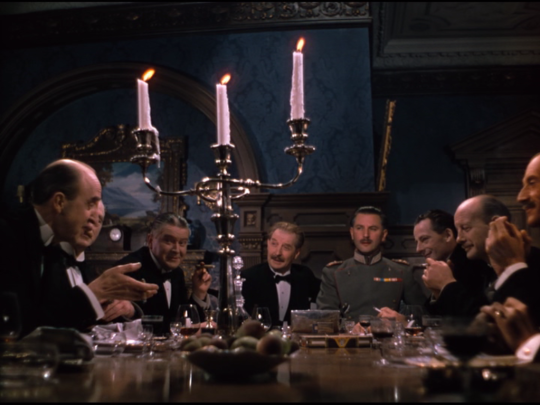
The Life and Death of Colonel Blimp ends wistfully, as Clive surveys the literal waterlogged wreckage of his life, having lost his house in the Blitz. He, Theo, and Johnny stand by the debris, and he recalls Barbara’s long-ago declaration: “You’ll stay just as you are till the floods come.” As he looks at where his house once lay, he says to himself, “Now here is the lake and I still haven’t changed.” Livesey, one of the very best actors to work with the Archers, imbues that line with a fine blend of pride and heartache, as he does with the salute he gives to the passing, much younger army of his native land. This elder statesman isn’t quite Colonel Blimp, only grasping Theo’s warnings about the Nazis after it’s too late, but he can see complexities of his life where others might not.
It took The Life and Death of Colonel Blimp, like the other films explored here, years to fully get its due in the U.S. While Churchill didn’t bar Blimp from release in the United Kingdom, he enforced an export ban on the feature because he saw it as a less-than-helpful presentation of the military at such a dire period. (Or, as some have wondered, he may well have seen the older Clive Candy as a critique of him. Of course, Churchill reportedly never saw this film, because that would have been too challenging.) A shortened version was released in U.S. theaters in 1945, cutting out the flashback structure. The truncated TV version, which runs just 90 minutes—the original is 163 minutes— was still able to excite a young Scorsese, who helped fund a restoration in 2013 for this classic.
The Life and Death of Colonel Blimp was, perhaps, doomed for failure; its treatment of people perceived as the enemy could gain resonance only with distance from WWII. The British War Office and Churchill stated their antipathy to the production even before it began filming, refusing the Archers’ request to release Laurence Olivier from service to star as Candy. (Livesey, to note, is wonderful in the film, so the Archers’ loss is our gain.) But Clive Candy was able to weather attacks, and so too was Blimp, the beginning of a seven-year period where the Archers upended expectations, strove to break cinematic ground, and stayed true to their artistic principles. Here is the lake, and still, this movie hasn’t changed. It only grows with age.
* * *
“It’s a great thing to sit back in an armchair and watch the world go by in front of you.” – Sgt. Bob Johnson
“The drawback is…that people may get used to looking at life from the sitting position.” – Thomas Colpeper
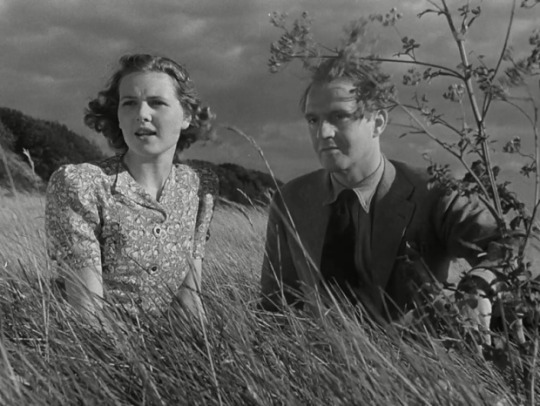
Fourteen months after The Life and Death of Colonel Blimp, Powell and Pressburger released another film set during World War II, which presented both the natural wonder and beauty of England while calmly displaying the ways in which the war had devastated some of its history. A Canterbury Tale wasn’t a hit with critics or audiences in the late summer of 1944; by the time it was released in the United States, the year was 1949, and a movie about three young strangers who journey towards Canterbury Cathedral in the waning months of World War II needed new, American-focused framing scenes to entice audiences.
Over 70 years after its initial release, what can we make of A Canterbury Tale? The allure of this low-key drama is, like its setting, ineffable and mysterious. The three leads, waylaid in the small English town of Chillingbourne while they wait for another train to Canterbury, ostensibly try to solve a mystery whose solution isn’t that mysterious. Some aspects of this film—whose three protagonists were all newcomers—feel less like drama and more like the Archers trying to make UK citizens turn away from the dark days of World War II and remind them of their land’s own beauty. From the vantage point of the 21st century, A Canterbury Tale is an utterly fascinating and serene look at how small towns tried to maintain a community-wide calm in the midst of terror.
Bob Johnson (Sgt. John Sweet) is an American soldier on his way to Canterbury Cathedral to meet a fellow Yank and do right by his mother back home in Three Sisters Falls, Oregon. Peter Gibbs (Dennis Price) is a British soldier who seems outwardly as arrogant as Blimp’s Spud Wilson, even though his true passion is playing the organ. While he plays it at cinemas back home, he’d rather play the kind of organ in the handsomely appointed Canterbury Cathedral. Alison Smith (Sheila Sim) has been conscripted into the Women’s Land Army; assigned to a farm in Chillingbourne, she has personal memories from her time near Canterbury that she can’t help but unearth. These strangers are brought together one dark Friday night by happenstance: Bob misheard the station stop and got off early, but he and Peter end up helping Alison after she’s beset upon by a mysterious figure who puts, of all things, glue in her hair. Strangest of all, this isn’t the first time a young woman was attacked by “the glue man” in Chillingbourne.

In a more predictable film, this inciting incident would lead our trio down some dark paths in Chillingbourne, a name that portends something terrifying. But while there’s an unquestionably disturbing subtext to a man placing “sticky stuff,” as Alison describes it, in young women’s hair, there’s little in the way of conventional twists in A Canterbury Tale. When our heroes meet Thomas Colpeper (Eric Portman), the magistrate of Chillingbourne who’s coincidentally the farmer to whom Alison has been assigned, it’s immediately obvious that he’s the glue man. Our heroes use the summer weekend, as they wait for the next train to Canterbury, to build up evidence, but as the weekend progresses, Bob and Alison (and eventually Peter) lose interest in solving the case as they fall in love with the British countryside.
Unlike Blimp, A Canterbury Tale has an ensemble of disparate characters who mostly have never seen serious battle. So many of them are average people conscripted into action, trying not to admit how terrified they feel. A Canterbury Tale features no bloodshed, but Powell and Pressburger stuck to the notion of making the film feel like a document of regular civilians by casting few recognizable actors. Portman worked with the Archers on the earlier film 49th Parallel and was, at the time, this film’s most well-known actor. Sweet, on the other end of the spectrum, was the least well-known; this was his first and only role in a film.
Recently, much was made about how Clint Eastwood’s The 15:17 to Paris, in which three young men who foiled a real-life attack, feature those three men playing themselves. When Powell and Pressburger cast their American character, they didn’t change his name to match the actor’s, but they might as well have: John Sweet was an Army Sergeant at the time, and his first-time performing style is always evident. Unlike the performances in The 15:17 to Paris, however, Sweet’s work is oddly charming. Watching him interact with the ensemble allows for the understandable awkwardness of his performance to take on a double meaning; Sweet is the outsider as much because he’s untrained as because he’s American. Bob Johnson is incurably curious and inquisitive, having so little awareness of British traditions, making his languorous journey through Chillingbourne all the more compelling.
By the close of A Canterbury Tale, all three of our heroes receive a blessing in the style of Geoffrey Chaucer’s Canterbury Tales. For Bob, it’s a revival of a romance he presumes is finished. His paramour, who he figured had moved on, has instead joined the Women’s Army Corps in Australia and has responded to the letters he thought had been ignored. Even before that, the people Bob meets in Chillingbourne, from the boys playing soldier to the local mechanics and a fellow military man from Seven Sisters in England, serve as a kind of blessing. When we first meet Bob, he’s all too happy to get his visit to Canterbury out of the way; before the movie ends, he’s taken to running down the sloping hills of Chillingbourne with his new friends, an overgrown boy at play. Stopping in Chillingbourne brings him joy even before his love life is given a new chance.
Alison, too, becomes closer to nature as she explores Chillingbourne. Of all people, she finds herself associating with Colpeper, even after she’s correct in presuming that he’s the culprit. Her blessing arises from memories she has of spending a summer outside Chillingbourne in a caravan with her fiancé, now presumed dead. But before she can receive the happy news that her fiancé is alive and well, she has to almost commune with the Earth to try and move on. By the second half, Alison is so in touch with nature that she hears the sounds of music and voices in the hills, akin to the centuries-old pilgrims Chaucer wrote about.
Alison’s connection is validated and shared by Colpeper, with whom she’s convening in those same hills Bob runs down. Even after Alison confirms Colpeper’s nighttime habits, she admits, “I was very mistaken about you.” Their connection is more emotional than anything else; Colpeper tells her that hearing voices as she does only works “when you believe strongly in something.” Colpeper’s strong belief in respecting Britain’s history is how he became the glue man. After his historical lectures were met with boredom and few attendees, he made it so British soldiers had little choice but to listen about their homeland’s history. By giving the soldiers a bad name (other townspeople, including the young women, presume one of them is the glue man), Colpeper assumed he could make a small encouragement to the British military to learn about the land it defended. As he explains to Peter on the train to Canterbury, “There’s no sin in being a savage, but a missionary who doesn’t try to do his duty is a bad missionary.”
Though Portman’s enigmatic performance turns Colpeper frosty even here, the magistrate receives a blessing from an unlikely source: Peter. Though Peter is the most gung-ho of the three young people to find the glue man, he chooses not to give Colpeper away to the authorities after he receives his blessing: the chance to play the Canterbury Cathedral organ. But Peter’s decision to let Colpeper walk is portended in one of the wonderful flourishes thrown in by the Archers in the film’s lush black-and-white cinematography. While on the train to Canterbury, Peter scoffs in response to the magistrate asking him if he is an instrument of judgment and says, “I’ll believe that when I get a halo over my head.” Cue the train light creating a halo effect over him.

There is no action-heavy setpiece in A Canterbury Tale, which instead features plenty of images of the main characters taking in the beauty of Chillingbourne. Through Colpeper, we see how hard it is for regular people to both support the military in wartime and forgive soldiers their vices. Through Peter, we see how soldiers didn’t quite grasp that their presence in small towns threw other people’s lives into upheaval. You could argue that very little happens to the characters in A Canterbury Tale; all that does happen is that Powell and Pressburger let the audience watch these people’s unremarkable yet compelling lives, and that they each secretly want to find some purpose when they arrive in Canterbury. The heroes appreciate what it meant to be British in decades gone by, and reflect on how that impacts their actions in the present. A Canterbury Tale was a love letter to England, made as gorgeous by its rolling hills as by its people. Though it didn’t hit big originally, and additional footage featuring Bob reconnecting with his girlfriend (Kim Hunter, about whom more very shortly) didn’t help it translate in America, A Canterbury Tale is a truly entrancing story of how badly people needed their unique burdens eased in such a horrific time of history.
* * *
“This is the universe. Big, isn’t it?” – Narrator

It’s hard to decide which is the best Archers film. Black Narcissus and The Red Shoes, perhaps their most broadly appreciated films in America, are remarkable leaps forward for Technicolor cinematography, while showcasing incredible performances, breathtaking set designs, and more. They are gorgeous films, featuring some of the most jaw-dropping images in the Archers’ filmography. But the film released the year before, suggesting the possibilities of what the Archers would do next, is just a touch greater. It is a film that was well-received initially, despite receiving a new title for its U.S. release; a film that’s only getting its first Region 1 Blu-ray release this summer although it offers some of the richest, most colorful images in Three-Strip Technicolor; a film that’s influenced everything from The Simpsons to Harry Potter. It is A Matter of Life and Death.
What if someone was supposed to die, but got misplaced? What if that person, with their extra time, fell in love before they were found by their bringer of death? This, in effect, is the concept of A Matter of Life and Death, in which Peter Carter (David Niven), a cheerful RAF pilot, is meant to die when he escapes his damaged plane without a parachute. Before Peter jumps, he contacts June, a winsome young American radio operator (Hunter), to share what he presumes are his last thoughts in the strangest Meet Cute ever. Peter jumps from quoting Walter Raleigh to brazenly declaring, “I love you, June. You’re life, and I’m leaving you.” But once Peter exits the plane, the damnedest thing happens: he wakes up on the beaches of England very much alive, after which he meets June in person, officially starting their relationship.
The whimsy of A Matter of Life and Death is clarified when we learn why Peter was apparently able to cheat death: his French conductor (Marius Goring, who co-stars in The Red Shoes) couldn’t locate Peter in the thick English fog. Peter is dismayed to learn that his permanent eternal presence is requested in the Other World, taking him away from June. She, of course, is concerned that her new boyfriend might be going mad; kindly local doctor Frank Reeves (Livesey again) believes Peter might be suffering from a brain injury. The perpetually unanswered question is just that: is Peter hallucinating the Other World because his mind is going, or is he really at death’s stairway?
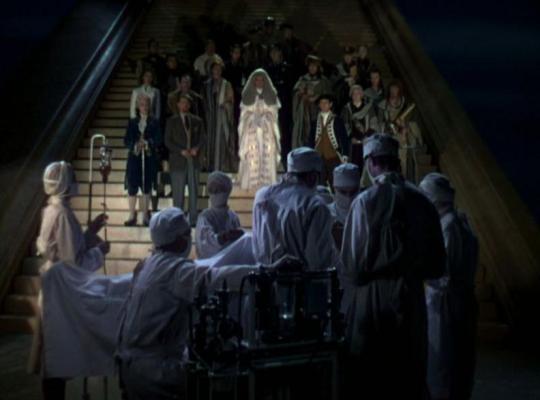
Powell and Pressburger don’t answer the question, providing just enough medical details, down to the smell Peter notices when he speaks to his Conductor, that it might just be a mental malady. (I submit that Peter isn’t hallucinating the Other World because the film never answers one question: how the hell did he survive that fall from the plane?) The closing moments of the film suggest that either option is possible, when it’s revealed that the judge of the Other World’s court of appeals and the surgeon operating on Peter are played by the same actor.
But the mystery of Peter’s circumstances is not what makes A Matter of Life and Death so special. This is one of the most ambitious films the Archers ever made. It is a buoyant, bursting-with-emotion romance between two star-crossed lovers whose connection is straight out of a fairy tale. It is a film designed to help bridge divides between the British and the Americans in the immediate aftermath of World War II. (The story begins just six days before the European section of WWII concluded.) And it is, above all else by the finale, meant as a rousing and spirited defense of the British people. When the Other World allows Peter to appeal his case, he chooses the firm, well-spoken Reeves—who dies tragically in a motorcycle accident before Peter’s surgery—to plead Peter’s case, passionately arguing in favor of his client’s basic humanity.
In these spectral, spiritual moments, Reeves goes head-to-head with Abraham Farlan (Raymond Massey), the first American felled by a British bullet in the Revolutionary War, in arguing for Peter’s clemency. But it becomes clear that Reeves and Farlan are not arguing over Peter’s right to live longer than originally planned: they are debating what it means to be British and to be American. Farlan doesn’t think much of the romance between Peter and June, seeing it as another case of two people ruining relationships back home because they’re thrown into unexpected circumstances abroad: “Men and women thousands of miles away from the love they left behind. Minute sparks, instead of scorching flames.”
This is the Archers’ irreverent way of presenting the British and American states of mind post-WWII. It’s also a sign of their empathy as filmmakers: when Reeves argues that the current jury—all men from different countries around the world impacted by England’s imperialist rule at varying points of history—is unfairly biased, he asks for six American citizens. The reveal is powerful in 2018 as much as it may have been in 1946: the six American citizens are all immigrants, French to African to Irish. There is no one type of American citizen, as there is no one type of British citizen: this film is a dissertation on what it is to be human.

Visually, A Matter of Life and Death is unparalleled in the Archers’ work; the cinematography shifts from Technicolor (in the real world) to black-and-white (in the Other World), and the design of the Other World creates a series of gasp-inducing images. There is the impossibly wide shot of the attendees of Peter’s appeal, in a vast auditorium that reveals itself to be the size of an entire galaxy; there is the design of the literal stairway to heaven (hence its American title, Stairway to Heaven), which seems appropriately infinite without being terrifying; there is the moment when Peter’s fellow RAF pilot, waiting for him in the Other World, peers down to the vast center where files on all people from Earth are kept, and we see his silhouette from far above. The sense of scope and scale in moments like these should be teachable moments for anyone crafting some big-budget spectacle; this film’s moments of wonder were accomplished with a meager budget.
The grandness of A Matter of Life and Death—a movie that begins with the camera panning through the vast universe and closes with lovers reuniting happily—is coupled by its creators’ aims, to emphasize the humanity in people of different creeds and cultures. Peter Carter seems almost carefree in his opening scene, throwing slang left and right to the woman who he’ll fall for even as he expects to die. By the end, Peter and June are united by what Reeves deems the most powerful force on Earth: love. It’s a declaration that manages to be corny and life-affirming at the same time, much in the same way as Powell and Pressburger attempt to emphasize the universal qualities of mankind throughout the spiritual-court climax. In this film, as in The Life and Death of Colonel Blimp and A Canterbury Tale, to be British is to be human.
* * *
Unlike some of their British cohorts, such as David Lean and Alfred Hitchcock, most of the Archers’ films didn’t immediately hit big in America. Powell’s 1960 horror film Peeping Tom didn’t exactly end his career (he kept making films after that disturbing effort), but it garnered fiercely negative criticism. Over the last couple of decades, the Archers’ films have received well-deserved revivals. Last year, A Matter of Life and Death received a 4K restoration overseen by Scorsese and Schoonmaker, which is translating to the film soon receiving a Region 1 Blu-ray from the Criterion Collection. (It is painfully overdue.) Before that, The Life and Death of Colonel Blimp and the operatic The Tales of Hoffman both received restorations, hopefully introducing more people to the wonder of these filmmakers.
The Life and Death of Colonel Blimp, A Canterbury Tale (which also deserves the Blu-ray treatment), and A Matter of Life and Death are the product of fertile creative minds who used the backdrop of World War II to explore vastly different worlds that all happen to exist in Great Britain. This trio runs the gamut of genres and emotions, all while showcasing the kind of soldiers who protected the United Kingdom throughout the first half of the 20th century. The raffish romantic lead of A Matter of Life and Death could easily have been the same kind of soldier to surprise the elderly Clive Candy in the opening of Blimp, or he could have just as easily stumbled across Chillingbourne’s glue man. He could have even been the young Clive Candy. These characters are distinct enough to exist within their own stories as they are to represent attitudes and personalities across all of the Archers’ films. These films encompass a vast universe, one that offers new wonders to cinephiles. Just as the pilgrims came to Canterbury for blessings, so too do true cinephiles receive blessings when they make the pilgrimage to watch Powell and Pressburger’s films.


